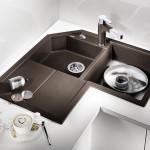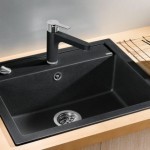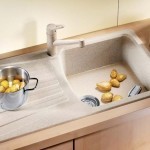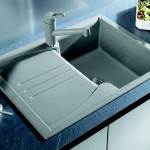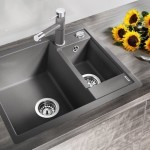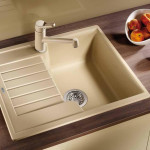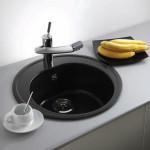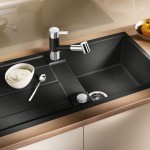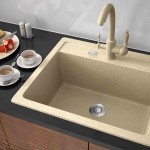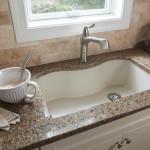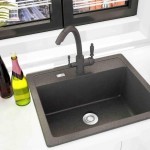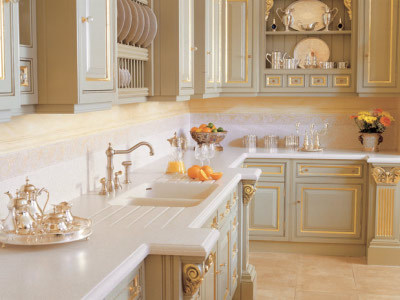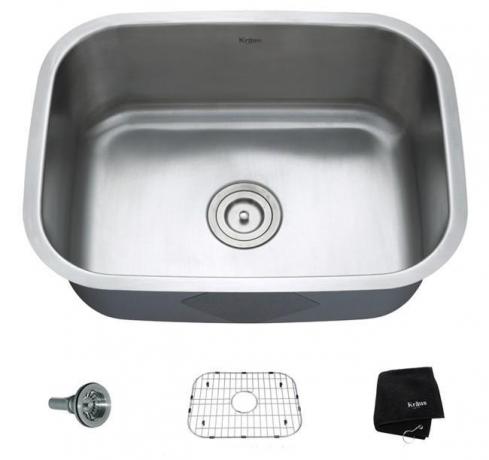Content
-
1 Advantages and disadvantages
- 1.1 Benefits
- 1.2 disadvantages
- 2 Shapes and colors
- 3 Installing a sink in 5 steps
- 4 Finally
- 5 Gallery
Porcelain stoneware sinks have firmly established their niche among the most popular kitchen accessories. Today we will tell you about the advantages and disadvantages of similar products, their types and installation method.

Granite sinks are stylish and durable
Advantages and disadvantages
Porcelain stoneware, from which kitchen sinks and countertops are made, is produced by pressing clay rich in illite and kaolite at a pressure of 400 to 500 kg / cm2 and a temperature of 1200⁰C-1300⁰C.

Narrow or wide porcelain stoneware products are popular for a reason
The result is a product that is not inferior in its parameters to granite or marble. A sink made of such a material is somewhat more difficult to install, but it is much more attractive in appearance and, perhaps, even more practical than ordinary ceramics.

Porcelain stoneware is a material that is not only attractive from an aesthetic point of view, but also practical
Benefits
Porcelain stoneware sinks have a number of impressive advantages that set them apart from their cheaper counterparts.

Products made of artificial granite surpass products made of natural stone in terms of moisture resistance
- Water resistance. Artificial granite sinks for the kitchen are even slightly superior to natural material in terms of technical characteristics for domestic use. For example, if we compare the water absorption capacity of artificial and natural granite, then in the first it is lower and is only 3.5%, while in natural stone it is all 5%.
- Ease of care. The kitchen sink made of granite can be washed by almost any means, that is, the material is neutral to chemical solvents.

Almost any cleaning agent can be used to clean the surface
- Resistance to mechanical damage. It is almost impossible to leave a scratch on such a surface (unless you do it deliberately, for example, with a glass cutter). Among other things, such a sink or countertop has a very high impact resistance (unlike conventional ceramics). There are no scuffs on porcelain stoneware and no color depth is lost when exposed to ultraviolet rays.

It is quite difficult to damage an artificial stone - it is resistant to mechanical damage
- Resistance to temperature changes. Also important is the fact that porcelain stoneware is not afraid of the so-called thermal shock, and even the instruction does not warn against temperature extremes. This is very important for the kitchen sink, where hot water or even boiling water can be immediately replaced by a cold stream from the tap. Such "luxury" is completely unacceptable for ordinary ceramics, where the enamel surface is cracked from temperature extremes.

Constant change of temperatures is not capable of harming the product
disadvantages
Like any other material, porcelain stoneware also has its drawbacks. So before purchasing a product, you need to familiarize yourself with them. The disadvantages of such sinks include:
- Impossibility of repair. Even the formation of small chips and cracks leads to a complete replacement of the product. They cannot be restored.

Even a small chip leads to a complete replacement of the shell
- The need for constant cleaning. A sink made of porcelain stoneware must be cleaned several times more often than a product made of the same stainless steel. In addition, do not forget to wipe the surface with a dry cloth after cleaning. This will prevent unpleasant streaks from forming.
- High price. The cost of granite products is not available to everyone. Yes, such a sink will be cheaper than a marble sink, but much more expensive than a steel one. But here it is worth considering that buying such an accessory, you are making an investment for many years to come. So the accessory is worth every penny spent on it.

The cost of a porcelain stoneware accessory is quite high, but it will serve you for many years
Read also the article on the kitchen sink made of artificial stone.
Shapes and colors
The kitchen sink is one of the most functional accessories. That is why, the choice of its form must be taken responsibly. To facilitate your choice, we suggest that you familiarize yourself with the assortment of forms of this product.
Illustration |
Form and its features |
 |
Round one bowl. Most often it is produced in a round shape and in sizes 50:50 or 60:60. Ideal for small kitchens or for a family of two. |
 |
Double. Two sink compartments allow you to simultaneously wash dishes and defrost food. This option is the best fit for a large family. |
 |
Corner. Another option for a small kitchen with an L-shaped layout. Situated in a corner, it takes up little space while making the most of the space. |
 |
With wing. An additional surface is used for drying dishes or even as a work area. |
In terms of color solutions, your choice is almost unlimited (it can be black, white, beige or any other). Manufacturers offer many options for any interior. We would recommend choosing the color of the product to match the shade of the countertop so that the sink becomes a visual extension of the work area.

A variety of shapes, colors and designs allow you to fit the sink into any decor, a photo of this
Installing a sink in 5 steps
Stone sinks for the kitchen and bathroom can be divided not only by their shape, but also by their installation configuration, that is, such sinks are recessed and integrated.
- Mortise. These include containers that require a hole in the worktop to install.
- Integrated. These are tanks that are one piece with the countertop and one cabinet is enough to install them.

Mortise models are most often purchased with a headset
Let's consider how to fix and install the sink with your own hands. If you follow the instructions, it will not be so difficult. To do this, you need:
- directly washing;
- jigsaw;
- drill;
- pencil;
- sealant.
| Illustration | Instructions for action |
 |
Step 1. Tabletop layout The manufacturer supplies a template for most sinks. If it is not there, turn the product over, install it in the most optimal place for you. Trace the outline with a pencil. Step back inward from the first line 1.5-2 cm (depending on the size of the side) and draw a cutting line. |
 |
Step 2. Creating a hole for a sink On the inside of the marked line, start drilling the hole with a jigsaw. To prevent a piece of table top from falling suddenly, gradually insert wedges into the cut. |
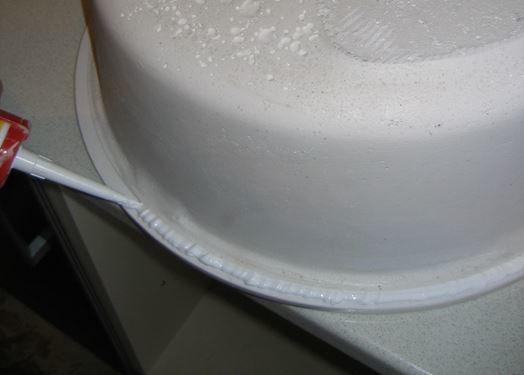 |
Step 3. Sealant application Apply some sealant along the entire saw cut line. It will keep moisture out of the sink. It is also necessary to apply silicone to the inside of the sink rims. |
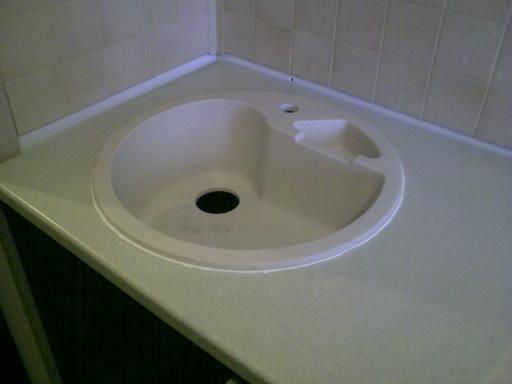 |
Step 4. Installation of a sink Carefully turn the sink over and slide it into the hole. Be careful not to rub the edges with the sealer on the countertop. |
 |
Step 5. The final stage Connect the siphon to the sewer pipe. Connect the flexible hose of the mixer to the water pipes. |
Finally
We told you about the main advantages and disadvantages of granite sinks and considered what forms of sinks are designed for this or that type of kitchen. You also learned how to install a sink in your kitchen in 5 steps. You can find more detailed instructions on the proposed video.
How to clean the kitchen sink - see here.





